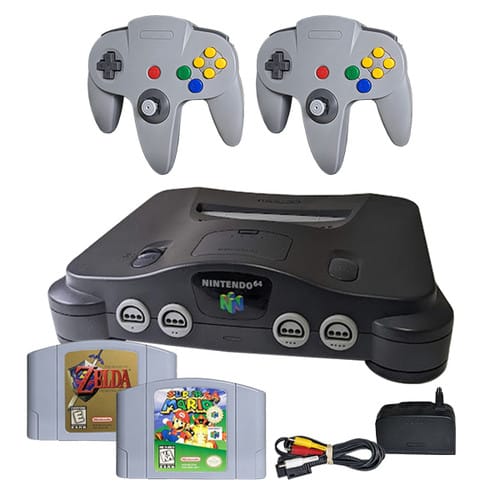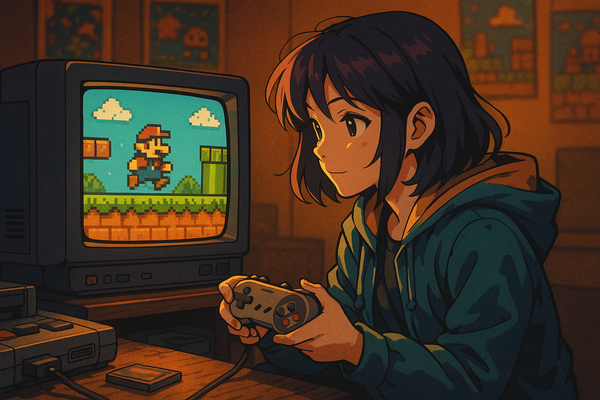Nintendo 64 (N64): Redefining gaming in three dimensions
Released in 1996, the Nintendo 64 (N64) marked a pivotal moment in gaming history. As the first Nintendo console to embrace 3D graphics, the N64 introduced a generation of players to immersive, three-dimensional worlds that redefined how games were played and experienced. Named after its 64-bit architecture, the N64 delivered unprecedented power for its time, enabling games to feature expansive environments, intricate level design, and smooth animations.

Nintendo’s decision to stick with cartridge-based games rather than adopting the CD-ROM format had both benefits and drawbacks. While cartridges ensured fast load times and durability, their limited storage capacity posed challenges for developers and led to higher production costs. Despite this, the N64 became a beloved console, celebrated for its groundbreaking titles and multiplayer-focused experiences.
Innovations in 3D gaming
The N64’s controller was a key innovation, featuring an ergonomic design and an analog stick that allowed for precise control in 3D spaces. This made it ideal for navigating the open worlds and complex environments that defined many of the console’s best games. The controller also included a Z-trigger, which became a staple for targeting mechanics in action and adventure games.
One of the console’s most significant contributions to gaming was its emphasis on local multiplayer. With four controller ports built into the system, the N64 became synonymous with social gaming, offering unforgettable multiplayer experiences in titles like Mario Kart 64, GoldenEye 007, and Super Smash Bros. The console’s ability to bring people together for couch gaming sessions remains one of its most cherished legacies.
The Legend of Zelda: Ocarina of Time
No discussion of the N64 is complete without mentioning The Legend of Zelda: Ocarina of Time. Released in 1998, this action-adventure game is widely regarded as one of the greatest video games of all time. Directed by Shigeru Miyamoto and Eiji Aonuma, Ocarina of Time transported players to the land of Hyrule, where they embarked on an epic quest as Link to save Princess Zelda and defeat the evil Ganondorf.

Ocarina of Time revolutionized gaming with its innovative mechanics and immersive storytelling. The introduction of Z-targeting allowed players to lock onto enemies and objects, simplifying navigation and combat in 3D spaces. The game’s expansive world, dynamic time system, and intricate dungeons set new standards for the action-adventure genre. Its memorable soundtrack, composed by Koji Kondo, added emotional depth to every moment, from the serene melodies of Kokiri Forest to the haunting notes of the Temple of Time.
The game’s success was both critical and commercial, selling over 7 million copies and earning countless Game of the Year awards. Its influence can be seen in virtually every 3D adventure game that followed, making Ocarina of Time a defining moment not just for the N64 but for gaming as a whole.
The N64’s game library
The Nintendo 64 boasted a library of games that pushed the boundaries of creativity and design. Super Mario 64, the console’s launch title, redefined platformers by introducing players to fully 3D gameplay and setting the gold standard for the genre. GoldenEye 007 became a cultural phenomenon, pioneering first-person shooters on consoles and establishing the framework for multiplayer FPS games.
Other standout titles included Banjo-Kazooie, Star Fox 64, Pokémon Stadium, and Paper Mario. Each game showcased the N64’s technical capabilities and reinforced Nintendo’s reputation for crafting innovative and engaging experiences. Despite the challenges posed by the cartridge format, developers managed to create some of the most iconic games in history.
The legacy of the N64
While the N64 faced stiff competition from Sony’s PlayStation and the growing popularity of CD-based gaming, it left an indelible mark on the industry. Its innovations in 3D gaming, local multiplayer, and controller design continue to influence modern consoles and game development.
For many players, the N64 was more than just a gaming console—it was a gateway to unforgettable adventures, cherished memories, and friendships forged over shared victories and defeats. The console’s emphasis on creativity and player experience has cemented its place as one of the most beloved systems in gaming history.
The enduring impact of the N64
Today, the Nintendo 64 remains a symbol of innovation and nostalgia. Its games are celebrated through remasters, re-releases, and emulation, ensuring that new generations can experience the magic of titles like Ocarina of Time and Super Mario 64. For millions of players, the N64 represents a golden era of gaming, a time when the possibilities of 3D worlds were just beginning to be explored.
The N64 wasn’t just a console; it was a revolution. It changed the way we play, the way we experience stories, and the way we connect with others through gaming. Its legacy continues to inspire, reminding us of the boundless potential of video games.

